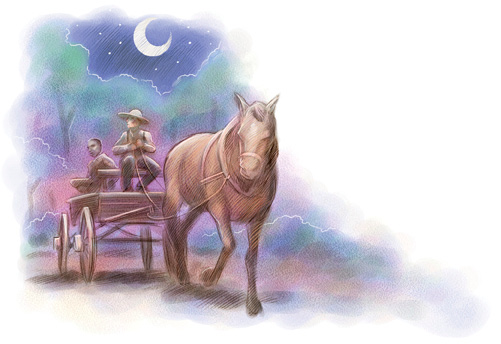Allen Jay, Conductor on the Underground Railroad

Folks in Randolph, Ohio, might not have noticed anything different about 11-year-old Allen Jay on July 1, 1842. He finished his chores, grabbed his fishing pole, and headed for his favorite fishing spot, just as on any other day. But within hours, he would become one of the youngest people ever to work on the Underground Railroad.
A Secret ‘Train’
The Underground Railroad had no engine, train cars, or tracks. It was an enormous network of homeowners sympathetic to the plight of the slaves who secretly transported runaway slaves to freedom. In the years leading up to the Civil War, they hid the runaways and guided them from one safe place to another, but they had to stay one step ahead of the slave catchers who wanted to capture the slaves. Those who led the runaways to safe hiding places were “conductors,” the hiding places were “stations,” and the escaped slaves “passengers.” The ultimate destination for the travelers was either the Northern free states or Canada, where slavery was not tolerated and which slave catchers could not enter.
Allen’s family belonged to a peaceful religious group called the Quakers, whose members were active in the Underground Railroad. Allen knew that African Americans were led to his parents’ home in the middle of the night. He knew that his parents often fed and hid these runaway slaves. But he and his brother and sisters never asked questions. They understood that all visitors to their home were welcome.
On the Lookout
Allen had nearly reached the path leading to his fishing pond when a neighbor and fellow Quaker rode up to the Jay family barn. Allen stopped and listened. The man told his father that an escaped slave was hiding in the nearby woods. A team of armed men was after him. Mr. Jay sent Allen to the cornfield to watch for the man, lead him to the walnut tree in the center of the cornfield, and instruct him to stay there.
Soon Allen heard rustling in the woods. When he walked toward the sound, he saw a black man hiding in the brush. Allen trembled. He had been born with a hole in the roof of his mouth that made his speech difficult to understand. In slow, shaky words, Allen delivered his father’s message.
Henry James
The man let Allen guide him to the walnut tree. He introduced himself as Henry James and begged Allen to bring him water. As Allen raced home, he wondered how he would get food and water for the man. His father had warned him not to say anything. But his mother met him with a basket of food and water and told Allen to “take it to whoever is hungry.”
After Allen delivered the food and water, he returned home. A team of horsemen rode up to the Jay house. They asked his father if he had seen a runaway slave. Mr. Jay, who was bound by his religion to tell the truth, was able to honestly answer “no.” But the men were not convinced. They vowed to return the next day with papers to search the house and property. (At that time, slaves were considered property, so slave owners had the right to search for and reclaim escaped slaves, even in free states.)
To Grandfather’s House
That night, Mr. Jay asked Allen to drive to his grandfather’s house. Henry James was hidden in the horse-drawn buggy. As they started out, Allen jumped at every sound and shadow. He expected men on horseback to overtake and shoot him. But James began telling him stories about slavery and how desperately he wanted to be free.
Soon Allen forgot his fear. They reached his grandfather’s house safely, where an uncle waited with fresh horses to conduct James to the next station. Months later, Allen heard that James had arrived in Canada and was a free man.
Despite his speech disability, Allen became a minister, teacher, and well-known speaker. But he never forgot his first job as conductor on the Underground Railroad.
 Fast Fact: An estimated 100,000 slaves escaped on the Underground Railroad.
Fast Fact: An estimated 100,000 slaves escaped on the Underground Railroad.